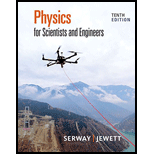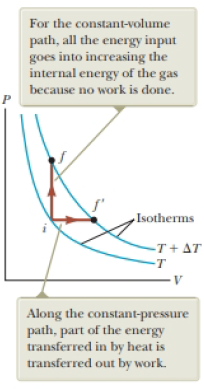
Physics for Scientists and Engineers
10th Edition
ISBN: 9781337553278
Author: Raymond A. Serway, John W. Jewett
Publisher: Cengage Learning
expand_more
expand_more
format_list_bulleted
Textbook Question
Chapter 20.2, Problem 20.2QQ
(i) How does the internal energy of an ideal gas change as it follows path i → f in Figure 20.4? (a) Eint increases. (b) Eint decreases. (c) Eint stays the same. (d) There is not enough information to determine how Eint changes. (ii) From the same choices, how does the internal energy of an ideal gas change as it follows path f → f′ along the isotherm labeled T + ΔT in Figure 20.4?
Figure 20.4 Energy is transferred by heat to an ideal gas in two ways.

Expert Solution & Answer
Trending nowThis is a popular solution!

Students have asked these similar questions
From this question and answer can you explain how get (0,0,5) and (5,0,,0) and can you teach me how to solve this
Can you solve this 2 question and teach me using ( engineer method formula)
11. If all three collisions in the figure below are
totally inelastic, which brings the car of mass (m) on
the left to a halt?
I
m
II
III
m
m
ע
ע
ע
brick wall
0.5v
2m
2v
0.5m
A. I
B. II
C. III
D. I and II
E. II and III
F. I and III
G. I, II and III (all of them)
Chapter 20 Solutions
Physics for Scientists and Engineers
Ch. 20.1 - Two containers hold an ideal gas at the same...Ch. 20.2 - (i) How does the internal energy of an ideal gas...Ch. 20.3 - Prob. 20.3QQCh. 20.3 - Prob. 20.4QQCh. 20 - A spherical balloon of volume 4.00 103 cm3...Ch. 20 - A spherical balloon of volume V contains helium at...Ch. 20 - A 2.00-mol sample of oxygen gas is confined to a...Ch. 20 - Oxygen, modeled as an ideal gas, is in a container...Ch. 20 - A 5.00-L vessel contains nitrogen gas at 27.0C and...Ch. 20 - Prob. 6P
Ch. 20 - In a period of 1.00 s, 5.00 1023 nitrogen...Ch. 20 - A 7.00-L vessel contains 3.50 moles of gas at a...Ch. 20 - Calculate the change in internal energy of 3.00...Ch. 20 - Prob. 10PCh. 20 - In a constant-volume process, 209 J of energy is...Ch. 20 - A vertical cylinder with a heavy piston contains...Ch. 20 - A 1.00-L insulated bottle is full of tea at 90.0C....Ch. 20 - A certain molecule has f degrees of freedom. Show...Ch. 20 - You are working for an automobile tire company....Ch. 20 - Why is the following situation impossible? A team...Ch. 20 - You and your younger brother are designing an air...Ch. 20 - During the compression stroke of a certain...Ch. 20 - Air in a thundercloud expands as it rises. If its...Ch. 20 - Why is the following situation impossible? A new...Ch. 20 - Air (a diatomic ideal gas) at 27.0C and...Ch. 20 - Prob. 22PCh. 20 - Prob. 23PCh. 20 - Prob. 24PCh. 20 - Prob. 25PCh. 20 - The law of atmospheres states that the number...Ch. 20 - Prob. 27APCh. 20 - Prob. 28APCh. 20 - The dimensions of a classroom are 4.20 m 3.00 m ...Ch. 20 - Prob. 30APCh. 20 - The Earths atmosphere consists primarily of oxygen...Ch. 20 - Review. As a sound wave passes through a gas, the...Ch. 20 - Prob. 33APCh. 20 - In a cylinder, a sample of an ideal gas with...Ch. 20 - As a 1.00-mol sample of a monatomic ideal gas...Ch. 20 - A sample consists of an amount n in moles of a...Ch. 20 - The latent heat of vaporization for water at room...Ch. 20 - A vessel contains 1.00 104 oxygen molecules at...Ch. 20 - Prob. 39APCh. 20 - Prob. 40APCh. 20 - Prob. 41APCh. 20 - On the PV diagram for an ideal gas, one isothermal...Ch. 20 - Prob. 43APCh. 20 - Prob. 44APCh. 20 - Prob. 45CP
Knowledge Booster
Learn more about
Need a deep-dive on the concept behind this application? Look no further. Learn more about this topic, physics and related others by exploring similar questions and additional content below.Similar questions
- How can you tell which vowel is being produced here ( “ee,” “ah,” or “oo”)? Also, how would you be able to tell for the other vowels?arrow_forwardYou want to fabricate a soft microfluidic chip like the one below. How would you go about fabricating this chip knowing that you are targeting a channel with a square cross-sectional profile of 200 μm by 200 μm. What materials and steps would you use and why? Disregard the process to form the inlet and outlet. Square Cross Sectionarrow_forward1. What are the key steps involved in the fabrication of a semiconductor device. 2. You are hired by a chip manufacturing company, and you are asked to prepare a silicon wafer with the pattern below. Describe the process you would use. High Aspect Ratio Trenches Undoped Si Wafer P-doped Si 3. You would like to deposit material within a high aspect ratio trench. What approach would you use and why? 4. A person is setting up a small clean room space to carry out an outreach activity to educate high school students about patterning using photolithography. They obtained a positive photoresist, a used spin coater, a high energy light lamp for exposure and ordered a plastic transparency mask with a pattern on it to reduce cost. Upon trying this set up multiple times they find that the full resist gets developed, and they are unable to transfer the pattern onto the resist. Help them troubleshoot and find out why pattern of transfer has not been successful. 5. You are given a composite…arrow_forward
- Two complex values are z1=8 + 8i, z2=15 + 7 i. z1∗ and z2∗ are the complex conjugate values. Any complex value can be expessed in the form of a+bi=reiθ. Find r and θ for (z1-z∗2)/z1+z2∗. Find r and θ for (z1−z2∗)z1z2∗ Please show all stepsarrow_forwardAn electromagnetic wave is traveling through vacuum in the positive x direction. Its electric field vector is given by E=E0sin(kx−ωt)j^,where j^ is the unit vector in the y direction. If B0 is the amplitude of the magnetic field vector, find the complete expression for the magnetic field vector B→ of the wave. What is the Poynting vector S(x,t), that is, the power per unit area associated with the electromagnetic wave described in the problem introduction? Give your answer in terms of some or all of the variables E0, B0, k, x, ω, t, and μ0. Specify the direction of the Poynting vector using the unit vectors i^, j^, and k^ as appropriate. Please explain all stepsarrow_forwardAnother worker is performing a task with an RWL of only 9 kg and is lifting 18 kg, giving him an LI of 2.0 (high risk). Questions:What is the primary issue according to NIOSH?Name two factors of the RWL that could be improved to reduce risk.If the horizontal distance is reduced from 50 cm to 30 cm, how does the HM change and what effect would it have?arrow_forward
- Two complex values are z1=8 + 8i, z2=15 + 7 i. z1∗ and z2∗ are the complex conjugate values. Any complex value can be expessed in the form of a+bi=reiθ. Find r and θ for z1z2∗. Find r and θ for z1/z2∗? Find r and θ for (z1−z2)∗/z1+z2∗. Find r and θ for (z1−z2)∗/z1z2∗ Please explain all steps, Thank youarrow_forwardAn ac series circuit consists of a voltage source of frequency 60 Hz and voltage amplitude V, a 505-Ω resistor, and a capacitor of capacitance 7.2 μF. What must be the source voltage amplitude V for the average electrical power consumed in the resistor to be 236 W? There is no inductance in the circuit.arrow_forwardAn L−R−C series circuit has R= 280 Ω . At the frequency of the source, the inductor has reactance XLL= 905 Ω and the capacitor has reactance XC= 485 Ω . The amplitude of the voltage across the inductor is 445 V . What is the amplitude of the voltage across the resistor and the capacitor? What is the voltage amplitude of the source? What is the rate at which the source is delivering electrical energy to the circuit?arrow_forward
- A 0.185 H inductor is connected in series with a 98.5 Ω resistor and an ac source. The voltage across the inductor is vL=−(12.5V)sin[(476rad/s)t]vL. Derive an expression for the voltage vR across the resistor. Express your answer in terms of the variables L, R, VL (amplitude of the voltage across the inductor), ω, and t. What is vR at 2.13 ms ? Please explain all stepsarrow_forwardA worker lifts a box under the following conditions:Horizontal distance (H): 30 cmInitial height (V): 60 cmVertical travel (D): 50 cmTorso rotation (A): 30°Frequency: 3 times/minute for 1 hourGrip: Good Question:What is the RWL for this task?What does this value mean in terms of occupational safety?arrow_forwardCan someone helparrow_forward
arrow_back_ios
SEE MORE QUESTIONS
arrow_forward_ios
Recommended textbooks for you
 Principles of Physics: A Calculus-Based TextPhysicsISBN:9781133104261Author:Raymond A. Serway, John W. JewettPublisher:Cengage Learning
Principles of Physics: A Calculus-Based TextPhysicsISBN:9781133104261Author:Raymond A. Serway, John W. JewettPublisher:Cengage Learning Physics for Scientists and Engineers, Technology ...PhysicsISBN:9781305116399Author:Raymond A. Serway, John W. JewettPublisher:Cengage Learning
Physics for Scientists and Engineers, Technology ...PhysicsISBN:9781305116399Author:Raymond A. Serway, John W. JewettPublisher:Cengage Learning Physics for Scientists and Engineers: Foundations...PhysicsISBN:9781133939146Author:Katz, Debora M.Publisher:Cengage Learning
Physics for Scientists and Engineers: Foundations...PhysicsISBN:9781133939146Author:Katz, Debora M.Publisher:Cengage Learning
 College PhysicsPhysicsISBN:9781285737027Author:Raymond A. Serway, Chris VuillePublisher:Cengage Learning
College PhysicsPhysicsISBN:9781285737027Author:Raymond A. Serway, Chris VuillePublisher:Cengage Learning Physics for Scientists and EngineersPhysicsISBN:9781337553278Author:Raymond A. Serway, John W. JewettPublisher:Cengage Learning
Physics for Scientists and EngineersPhysicsISBN:9781337553278Author:Raymond A. Serway, John W. JewettPublisher:Cengage Learning

Principles of Physics: A Calculus-Based Text
Physics
ISBN:9781133104261
Author:Raymond A. Serway, John W. Jewett
Publisher:Cengage Learning

Physics for Scientists and Engineers, Technology ...
Physics
ISBN:9781305116399
Author:Raymond A. Serway, John W. Jewett
Publisher:Cengage Learning

Physics for Scientists and Engineers: Foundations...
Physics
ISBN:9781133939146
Author:Katz, Debora M.
Publisher:Cengage Learning


College Physics
Physics
ISBN:9781285737027
Author:Raymond A. Serway, Chris Vuille
Publisher:Cengage Learning

Physics for Scientists and Engineers
Physics
ISBN:9781337553278
Author:Raymond A. Serway, John W. Jewett
Publisher:Cengage Learning
Thermodynamics: Crash Course Physics #23; Author: Crash Course;https://www.youtube.com/watch?v=4i1MUWJoI0U;License: Standard YouTube License, CC-BY